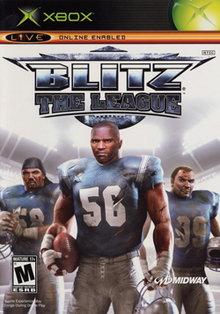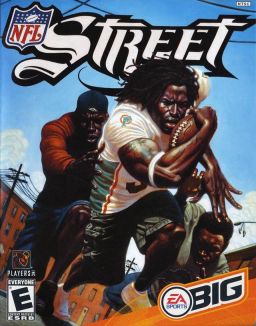
NFL Street is an American football video game developed by EA Tiburon and published by Electronic Arts under the EA Sports BIG label. It was released for the PlayStation 2, GameCube and Xbox on January 13, 2004. Barry Sanders of the Detroit Lions, Shannon Sharpe of the Denver Broncos, and Ricky Williams of the Miami Dolphins appear on the cover. The game was followed by NFL Street 2 and NFL Street 3.

Madden NFL 2004 is the 15th installment of the Madden NFL series of American football video games. Former Atlanta Falcons quarterback Michael Vick is on the cover.

All-Star Baseball 2005 is a baseball video game developed by Acclaim Studios Austin and published by Acclaim Entertainment for PlayStation 2 and Xbox in 2004. It was released exclusively in North America. The game features Derek Jeter on the cover. It is the eighth and last game in the series.

Madden NFL 2003 is an American football simulation video game based on the NFL that was developed by EA Tiburon and Budcat Creations and published by EA Sports. The 14th installment of the Madden NFL series, the game features former St. Louis Rams running back Marshall Faulk on the cover. This edition of Madden was the first to have EA Trax, the Mini Camp mode, and to feature Al Michaels as play-by-play announcer, who took over for Pat Summerall. Although it featured the expansion Houston Texans and the relocation of the Seattle Seahawks to the NFC, it was actually the second to do so. The game was released on August 12, 2002 for the Game Boy Advance, GameCube, Microsoft Windows, PlayStation, PlayStation 2 and Xbox. The PlayStation version also includes the Sega Genesis version of John Madden Football 93.
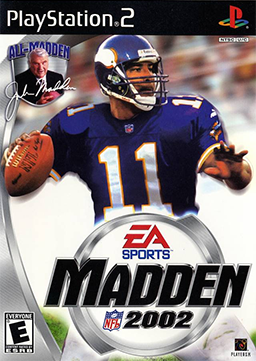
Madden NFL 2002 is an American football video game. It features former Minnesota Vikings quarterback Daunte Culpepper on the cover. Pat Summerall and John Madden are the commentators. The Madden NFL 2002 commercial first aired during Super Bowl XXXVI, three days after Madden NFL 2002 started selling in Japan. Notably, it does not feature the Super Bowl MVP Tom Brady, who is included on later editions of the game as a roster update. It is also the first game to be developed by Budcat Creations.

Madden NFL 06 is an American football video game released in 2005. It is the 16th installment of the Madden NFL series by EA Sports, named for color commentator John Madden. It is the first Madden game for the PlayStation Portable and Xbox 360 and was a launch game for the 360. Philadelphia Eagles quarterback Donovan McNabb is on the cover.
NFL Blitz is a series of American football themed video games originally released by Midway featuring National Football League (NFL) teams. It began as a 1997 arcade game NFL Blitz that was ported to home consoles and spawned a series of sequels. Rather than being designed as a realistic interpretation of the sport of football, like Madden NFL or NFL 2K, the Blitz series was created as an over-the-top, exaggerated version of the sport, inspired by Midway's own NBA Jam basketball games.

NHL Hitz 2002 is an arcade-style ice hockey video game released by Midway. It is the first game of the NHL Hitz series. Midway launched this game along with NFL Blitz.

NBA Ballers is a 2004 streetball simulation video game developed and published by Midway. The game features fictional NBA analyst Bob Benson and MC Supernatural as the commentators. A majority of the moves in the game were from amateur basketball players, who provided some of their moves for the game. Stephon Marbury is on the cover.

NCAA Football 2003 is a video game of the sports genre released in 2002 by EA Tiburon. Its cover athlete is former Oregon Ducks quarterback Joey Harrington.

World Series of Poker is a video game based on the popular gambling tournament World Series of Poker. It is succeeded by World Series of Poker: Tournament of Champions and World Series of Poker 2008: Battle for the Bracelets. It was released for the GameCube, PlayStation 2, Xbox, PlayStation Portable, and Windows.

Madden NFL 08 is a 2007 American football video game based on the National Football League that was published by EA Sports and developed by EA Tiburon. It is the 19th installment in the Madden NFL video game franchise. It features Tennessee Titans quarterback Vince Young on the cover; San Diego Chargers defensive end Luis Castillo was the cover athlete for the Spanish-language version. This was the first Madden game made for 11 different platforms, it was released on August 14, 2007, for Xbox 360, Wii, PlayStation 3, PlayStation 2, Nintendo DS, PlayStation Portable, Xbox, GameCube and Microsoft Windows. There was also a version for Mac released on September 1, 2007. This was the last version of Madden to be released for Microsoft Windows until Madden NFL 19, and the last video game for the GameCube produced and released in North America.

Splashdown is a water racing video game developed by Rainbow Studios and published by Infogrames originally for the PlayStation 2 and was later ported to the Xbox. It was released under the Atari brand name.
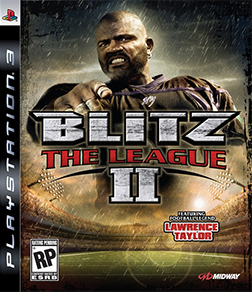
Blitz: The League II is an American football video game developed and published by Midway as part of its NFL Blitz series. It is a sequel to Blitz: The League. The game was released for the PlayStation 3 and Xbox 360 on October 13, 2008. There are five new teams included in this installment: The Los Angeles Riot, Houston Riders, Vancouver Beavers, Milwaukee Hounds, and Atlanta 404; and four older teams have been relocated. Lawrence Taylor (L.T.) is featured in the game, reprising his role as Quentin Sands.
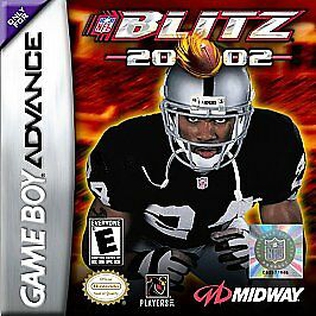
NFL Blitz 2002 is a video game published by Midway for Game Boy Advance in 2001, and for GameCube, PlayStation 2 and Xbox in 2002.
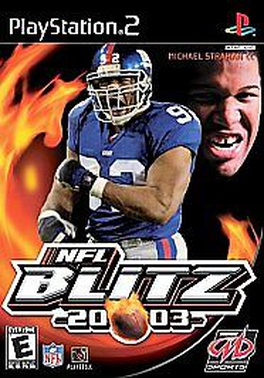
NFL Blitz 2003 is a video game published by Midway Sports for Game Boy Advance, GameCube, PlayStation 2 and Xbox in 2002.

NFL Blitz Pro is a video game developed by Midway Games for GameCube, PlayStation 2 and Xbox in 2003.

NCAA March Madness 2004 is the 2003 installment in the NCAA March Madness series. Former Syracuse player Carmelo Anthony is featured on the cover. Commentary is done by Brad Nessler and "Mr. College Basketball" Dick Vitale as he is introduced in the game. This is the first entry in which players can pick their favorite schools. The menus are then stylized in the school's colors, and a cheerleader or mascot can appear on the main menu the school's fight song plays. The game plays similarly to NBA Live 2004.

High Heat Major League Baseball 2004, also known as High Heat Baseball 2004 or High Heat 2004, is a video game released in 2003, and is the sixth and final game in the High Heat Major League Baseball video game series published by The 3DO Company, before it filed for bankruptcy in May 2003. The game was released on PlayStation 2, Xbox, and Windows. Versions of the game were also intended to launch on Nintendo's Game Boy Advance and GameCube consoles but were scrapped following 3DO's 2003 bankruptcy. Then-Arizona Diamondbacks starting pitcher Curt Schilling is featured on the cover.

NFL Blitz is a downloadable video game by EA Sports featuring the teams of the National Football League. It is a reboot of the NFL Blitz series, the first Blitz game officially sponsored by the NFL after a number of releases in the Blitz series which did not bear the NFL's official license. It was released in North American territories in January 2012 on both PlayStation Network and Xbox Live Arcade. Baltimore Ravens running back Ray Rice was selected to be the virtual cover athlete of the game. Play by play commentary was provided by Tim Kitzrow and color commentary by Brian Haley.
